 In the pocket of my motorcycle jacket I have a key chain holder of St Christopher. On my toiletry bag I pinned a lucky doll. And in my bag I carry: a lucky coin, a four-leaf clover, a happy buddha and a charm bracelet. All of them are presents to wish us a safe journey. I am a little superstitious, so everything got a place in my bag. And the collection was now expanded in Argentina, because at the back of our motorbikes are fluttering two red ribbons in the hope that “Difunta Correa” will help us.
In the pocket of my motorcycle jacket I have a key chain holder of St Christopher. On my toiletry bag I pinned a lucky doll. And in my bag I carry: a lucky coin, a four-leaf clover, a happy buddha and a charm bracelet. All of them are presents to wish us a safe journey. I am a little superstitious, so everything got a place in my bag. And the collection was now expanded in Argentina, because at the back of our motorbikes are fluttering two red ribbons in the hope that “Difunta Correa” will help us.
For a long time it was unclear to us what the red ribbons on the Argentine cars meant. We were just as curious about the many little chapels along the way, with red flags, water bottles and flowers. We thought they were put up for victims of road accidents, but we saw so many chapels that we could hardly imagine this. When we passed yet another one, we stopped to take a closer look and found the answers.
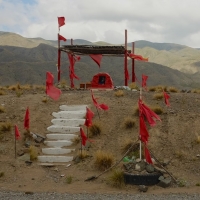 The little chapels with the red flags are for ’Gauchito Gil’. An Argentine folk hero from 1840, who suffered a tragic love life and was committed to take care of the poor. It is said that after his death Gauchito Gil miraculously healed a sick boy. He is regarded a patron of gauchos and is asked for happiness, love, health, healing and a safe journey. The little chapels with the water bottles are for Difunta Correa. The story goes that she went walking through the desert with her baby, heading for her husband who got injured in the war. She died when her water ran out. When her body was found four days later, the baby was still alive because her breast was miraculously still giving milk. She is patron of farmers, truckers and gauchos who bring bottled water to still her eternal thirst.
The little chapels with the red flags are for ’Gauchito Gil’. An Argentine folk hero from 1840, who suffered a tragic love life and was committed to take care of the poor. It is said that after his death Gauchito Gil miraculously healed a sick boy. He is regarded a patron of gauchos and is asked for happiness, love, health, healing and a safe journey. The little chapels with the water bottles are for Difunta Correa. The story goes that she went walking through the desert with her baby, heading for her husband who got injured in the war. She died when her water ran out. When her body was found four days later, the baby was still alive because her breast was miraculously still giving milk. She is patron of farmers, truckers and gauchos who bring bottled water to still her eternal thirst.
Difunta Correa was buried at Vallecito, near the spot where she was allegedly found. It is on our route, so we decide to go and have a look. In contrast to the modest chapels along the way, her grave has become a true sanctuary. A small village, with more 15 big chapels, hotels, restaurants and souvenir shops. Visitors are brought to the sanctuary with big tour buses. All of them with several bottles of water in their bags.
 Together with Ton and Marijke we climb the hill to the main chapel, which holds two life-size statues of Difunta Correa. She is depicted in a dark blue dress with one bare breast from which her baby is drinking. In the chapel several people are praying. In the corner young mothers are openly breastfeeding their children and outside an elderly couple adds bottles of water to the already huge collection of water bottles. Along the staircase are license plates and other car parts to thank her for safe kilometers. On the hill are miniature houses, to thank for the money to buy the house. She is also thanked for: winning of sports prizes, finding lovers, passing exams, successful operations, and so on. As down to earth Dutchmen we are astonished about the devotion to the mythical lady and the events that are attributed to her. Even for my little bit of superstition this is too much. As we walk back to the motorbikes we buy two red ribbons in one of the many shops. More as a souvenir than anything else. But, well, even if it won’t help, it won’t hurt either. It only remains to be seen whether her forces also work outside the borders of Argentina.
Together with Ton and Marijke we climb the hill to the main chapel, which holds two life-size statues of Difunta Correa. She is depicted in a dark blue dress with one bare breast from which her baby is drinking. In the chapel several people are praying. In the corner young mothers are openly breastfeeding their children and outside an elderly couple adds bottles of water to the already huge collection of water bottles. Along the staircase are license plates and other car parts to thank her for safe kilometers. On the hill are miniature houses, to thank for the money to buy the house. She is also thanked for: winning of sports prizes, finding lovers, passing exams, successful operations, and so on. As down to earth Dutchmen we are astonished about the devotion to the mythical lady and the events that are attributed to her. Even for my little bit of superstition this is too much. As we walk back to the motorbikes we buy two red ribbons in one of the many shops. More as a souvenir than anything else. But, well, even if it won’t help, it won’t hurt either. It only remains to be seen whether her forces also work outside the borders of Argentina.
From Vallecito we drive to San Agustin de Valle Fertil. It’s a lovely town with large trees lining the main street. It reminds us of villages in the south of France. It is warm and everyone is out on the street. Everyone seems to know each other, but we are warmly greeted as well. We end up staying three days, doing laundry, filling the fridge of the camper and doing some work on the bikes and the blog.
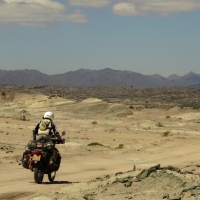 After three days we get back on the bikes to visit Regional Park Ischigualasto. A nature park in a valley with unusual rock formations, where a large number of dinosaur skeletons have been found. The park is perfect for a day of off-road riding, but unfortunately that is not possible. We can enter on the bikes, but we have to ride in a convoy and follow a guide to the different sights. There is already a long line of cars in front of the entrance as we get to the park. We follow the guide to various places in the park, where he tells us in rapid Spanish about the rocks and the special excavations. We have quickly lost him and instead walk around to take some pictures. It’s beautiful! We see unique ball shaped stones, colored rocks in the Valle Pintura and impressive formations in the Valle de la Luna. Whenever we go to the next place, we leave a gap with the cars in front of us so we can join them later at a bit faster pace. A nice ride after all.
After three days we get back on the bikes to visit Regional Park Ischigualasto. A nature park in a valley with unusual rock formations, where a large number of dinosaur skeletons have been found. The park is perfect for a day of off-road riding, but unfortunately that is not possible. We can enter on the bikes, but we have to ride in a convoy and follow a guide to the different sights. There is already a long line of cars in front of the entrance as we get to the park. We follow the guide to various places in the park, where he tells us in rapid Spanish about the rocks and the special excavations. We have quickly lost him and instead walk around to take some pictures. It’s beautiful! We see unique ball shaped stones, colored rocks in the Valle Pintura and impressive formations in the Valle de la Luna. Whenever we go to the next place, we leave a gap with the cars in front of us so we can join them later at a bit faster pace. A nice ride after all.
Just north of Ischigualasto lies National Park Talampaya.. It’s too late to visit the park today, but there are a number of camping spots at the entrance. We will spend the night here and visit the park tomorrow. Once the tent is pitched, we watch the sunset from our chairs. During the day it was pretty warm in the desert-like area, but now it quickly becomes chilly. It’s very dark and very quiet, especially now that the wind has dropped. In the distance we see a thunderstorm. Even few seconds the vast plain is lit by the lightning. After a while, the sky clears and the first stars appear. When we are camping we are outside a lot of the time and on nights like this that is certainly no punishment.
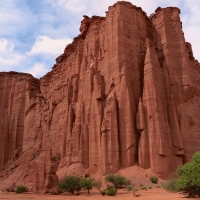 The next morning we walk with our cameras to the entrance of the park. We have to leave the camper and the bikes in the parking lot, because they are not allowed in this park. Instead, we take a seat in a huge truck that has been converted into a bus. While the guide (this time in clear Spanish) tells about the area, we drive through a narrow gorge. The cliffs are up to 150 meters high and go straight up. Water and wind have left beautiful traces in the red rock. In some places there are just some narrow columns. We stop several times to walk through the gorge. From the truck we see guanacos, foxes, green parrots and special petroglyphs. It is a beautiful area and we would have liked to ride around with the bikes here.
The next morning we walk with our cameras to the entrance of the park. We have to leave the camper and the bikes in the parking lot, because they are not allowed in this park. Instead, we take a seat in a huge truck that has been converted into a bus. While the guide (this time in clear Spanish) tells about the area, we drive through a narrow gorge. The cliffs are up to 150 meters high and go straight up. Water and wind have left beautiful traces in the red rock. In some places there are just some narrow columns. We stop several times to walk through the gorge. From the truck we see guanacos, foxes, green parrots and special petroglyphs. It is a beautiful area and we would have liked to ride around with the bikes here.
After visiting the park, we continue north the same afternoon. Our destination for today is Chilecito, a village 100 km away. A good distance for the afternoon. We’ve only just left when we are stopped at a police checkpoint. A friendly policeman tells us that the road is closed. If we want to go to Chilecito we first have to go to another valley, making it suddenly 250 km. We are not sure whether we can make it there before dark, but we have no choice but to turn around, open the gas and see how far we can get.
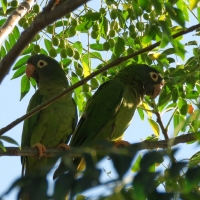 The bad weather we saw in the distance yesterday is now all around us. It rains and there is a strong wind. The bikes have a hard time with the wind and use more fuel than usual. We have to use the fuel from the jerry cans, because away from the main roads and major cities there are no gas stations here. Only after 150 km we find the first gas station. Now the next problem appears: we have no money! At least, no cash. In San Augustin we tried to change American dollars for Argentine pesos, but they had never heard of the ‘Blue dollar’. We had become so used to it that we had not even thought to withdraw money from the ATM. And here, at the small gas station, they do not take our dollars. And to our surprise our bank card does not work either. So no fuel. This way every ordinary ride can become a true adventure.
The bad weather we saw in the distance yesterday is now all around us. It rains and there is a strong wind. The bikes have a hard time with the wind and use more fuel than usual. We have to use the fuel from the jerry cans, because away from the main roads and major cities there are no gas stations here. Only after 150 km we find the first gas station. Now the next problem appears: we have no money! At least, no cash. In San Augustin we tried to change American dollars for Argentine pesos, but they had never heard of the ‘Blue dollar’. We had become so used to it that we had not even thought to withdraw money from the ATM. And here, at the small gas station, they do not take our dollars. And to our surprise our bank card does not work either. So no fuel. This way every ordinary ride can become a true adventure.
Without fuel we can’t go to Chilecito, because that is one straight road through the desert without any gas stations. Instead, we decide to go to La Rioja, a larger town east of Chilecito. With the fuel we have we should still make it. Our fuel gauge is already flashing for a while when we see the city loom in the distance. We immediately find a large gas station. The enthusiastic attendant finds the foreigners very interesting and seems almost proud when he says that we can pay with dollars. He leads us to the owner, Don Fabio. In a small room at the back of the building I am introduced to three older gentlemen. Each with a huge belly, a link chain necklace and a gold signet ring on their little fingers. They remind us of the men we saw in Naples, Italy. Only the sunglasses are missing. Don Fabio agrees to exchange dollars for a reasonably good rate. I give him a big stash of dollars and receive a handwritten note with which I can pick up the money from the attendant at the pump. This should be enough for the last week in Argentina.
 We fill up and bend over the map with Ton and Marijke. It’s too late to keep riding, so we need to spend the night in La Rioja. According to the guidebook, there is a campsite on the other side of town. We ride through the busy city and stop in a suburb. It must have been a good neighborhood at one point, with beautiful villas in large gardens, but everything is deserted now. The houses are in poor condition and the gardens are overgrown. It is already dark and raining, making everything look even sadder. And on top of that: there is no sign of the campsite!
We fill up and bend over the map with Ton and Marijke. It’s too late to keep riding, so we need to spend the night in La Rioja. According to the guidebook, there is a campsite on the other side of town. We ride through the busy city and stop in a suburb. It must have been a good neighborhood at one point, with beautiful villas in large gardens, but everything is deserted now. The houses are in poor condition and the gardens are overgrown. It is already dark and raining, making everything look even sadder. And on top of that: there is no sign of the campsite!
After we have made a tour through the neighbourhood, Marijke and I go to a cafe on the corner to ask for directions. It’s Saturday night and the staff is preparing for a busy night. In my best Spanish I ask the manager where the campsite is. He looks surprised: there is no campsite here. In the center are a few hotels, but he advises us not to go there to look for a room. He seems to think it is not safe and instead invites us to stay with him. First I still think I have misunderstood him, but then he explains that he has a large garden with space for the camper and our tent. Well, why not? We know nothing about the man, but it sounds like a good idea. Marijke looks a bit worried when I translate his proposal for her, but she soon agrees that we should accept his offer. During our trip we learned to rely on our gut feeling, especially with regard to people, and this feels OK.
 The manager introduces himself as Fabio and walks with us to Peter and Ton. They look surprised when we say that we will be staying in Fabio’s back garden, but they do not get much chance to veto our decision. Marijke takes place in the back of the camper and Fabio takes the passenger seat to show Ton where to go. Ten minutes later we park in a large garden and Fabio shows us the garden house. We can use the kitchen and the bathroom and can even sleep inside if we do not want to camp in the rain. After Fabio has shown everything, Peter takes him back to the cafe, leaving us speechless for a moment. It remains special how complete strangers open up their homes to us. The world is so much friendlier than you might think sometimes.
The manager introduces himself as Fabio and walks with us to Peter and Ton. They look surprised when we say that we will be staying in Fabio’s back garden, but they do not get much chance to veto our decision. Marijke takes place in the back of the camper and Fabio takes the passenger seat to show Ton where to go. Ten minutes later we park in a large garden and Fabio shows us the garden house. We can use the kitchen and the bathroom and can even sleep inside if we do not want to camp in the rain. After Fabio has shown everything, Peter takes him back to the cafe, leaving us speechless for a moment. It remains special how complete strangers open up their homes to us. The world is so much friendlier than you might think sometimes.
After a quiet night, we get up early the next morning. We thank Fabio for his hospitality and leave La Rioja with a full tank of fuel. We leave the desert landscape behind us and slowly drive up the green hills. It is immediately clear why it is so green because it rains almost the whole day. The road continues to climb until we arrive in Tafi del Valle that night, a small village at 2,000 m of altitude. We find a campsite, eat a pizza and go to bed early due to the bad weather.
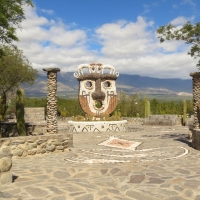 The next morning the sun shines when we leave. And that’s nice, because even with sun it is quite chilly at this altitude. And we have not even reached the top of the pass yet. We continue to climb and only reach the top at 3.000 m. On the other side of the mountain ridge the landscape looks very different. There is clearly not so much rain here. The green meadows have been replaced by rocky slopes full of cacti. We take our time for the ride down. We stop for pictures, find a nice place to have lunch and visit Museum Pachamama in the valley. At the end of the day we reach our destination for today: Cafayate. It is a beautiful village with an old town center, surrounded by vineyards. We find a spot at one of the campsites and immediately decide to stay a few days.
The next morning the sun shines when we leave. And that’s nice, because even with sun it is quite chilly at this altitude. And we have not even reached the top of the pass yet. We continue to climb and only reach the top at 3.000 m. On the other side of the mountain ridge the landscape looks very different. There is clearly not so much rain here. The green meadows have been replaced by rocky slopes full of cacti. We take our time for the ride down. We stop for pictures, find a nice place to have lunch and visit Museum Pachamama in the valley. At the end of the day we reach our destination for today: Cafayate. It is a beautiful village with an old town center, surrounded by vineyards. We find a spot at one of the campsites and immediately decide to stay a few days.
We have only just pitched our tent when we are visited by a street dog. Unlike in Europe, it’s not so common to neuter or spay dogs in South America. Many people have one or more dogs and there are a lot of stray dogs. At the campsite there are at least eight stray dogs, that all resemble the rottweiler of the neighbours. The little dog that came to visit us is wagging its tail and walks around our chairs to great everyone and then does not want to leave. Whenever we try to send him away, he lies down on his back with his paws up in the air to surrender. He seems especially fond of Marijke, who actually does not even like dogs that much. He follows her around the campsite, barking loudly to everyone they meet. 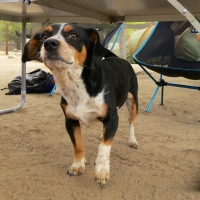 When we are in bed that night, I hear some rustling in the tent and then I feel how the little dog finds a place to sleep at our feet. It is not long before he is snoring loudly. Like the dog, we also surrender: he can stay.
When we are in bed that night, I hear some rustling in the tent and then I feel how the little dog finds a place to sleep at our feet. It is not long before he is snoring loudly. Like the dog, we also surrender: he can stay.
When we walk to the village the next day to do some shopping, “our dog” walks with us. Whenever we go into a store, he waits on the sidewalk to join us to the next store afterwards. We can’t help to buy some dog food and ask for a bowl of water at the pizzeria where have lunch. He seems to appreciate it all, obediently eats the chow and then falls asleep at our feet. It is a good thing that we have no place on the bikes for four-legged companions, because otherwise we would have already adopted a pack of dogs.
After a relaxing day at the campsite, we walk to the center of town again the next afternoon for some wine tasting. When the dog is not paying attention, we quickly leave so he will not follow us this time. We visit three wineries. After our wine tour in South Africa, it is nice to also taste some wine here. Cafayate is best known for the Torrontes grape, with which they make a delicious white wine. We drink all the little bits of wine they serve us to taste, and are a happily tipsy when we walk back to the campsite that night. And not empty handed, because we stocked up on wine for the next weeks.
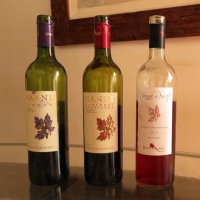 The next morning we are ready to go. It is difficult to say goodbye to ’our little dog’, but after an extra hand of dog chow we manage to leave. We are back on Ruta 40 and ride a beautiful route through the valley of the Rio Calchaqui. With dozens of bends the road follows the course of the river. Just next to the water the land is bright green, but away from the river the land is dry and barren. The gravel road is dusty and within a few kilometers our faces are too. It’s so hot in the valley that I’m surprised that people actually live here. We pass a few villages where it seems like time has stood still. The highlight of today’s trip is without doubt the Quebrada de las Flechas, an unusual rock formation where the road meanders through. At the end of the day we pitch our tent at a campground in Cachi.
The next morning we are ready to go. It is difficult to say goodbye to ’our little dog’, but after an extra hand of dog chow we manage to leave. We are back on Ruta 40 and ride a beautiful route through the valley of the Rio Calchaqui. With dozens of bends the road follows the course of the river. Just next to the water the land is bright green, but away from the river the land is dry and barren. The gravel road is dusty and within a few kilometers our faces are too. It’s so hot in the valley that I’m surprised that people actually live here. We pass a few villages where it seems like time has stood still. The highlight of today’s trip is without doubt the Quebrada de las Flechas, an unusual rock formation where the road meanders through. At the end of the day we pitch our tent at a campground in Cachi.
Before we leave the town again the next day, we first do some shopping. Cachi appears to be a very cute town with whitewashed houses with thick walls and heavy wooden doors. Like most villages there is a “plaza de armas”: a central square with a statue of a local or national hero and a landscaped park. It is market day. People from the farms around Cachi come to town to sell their vegetables and fruits. And they do so from the trunks of their cars, that are filled with tomatoes, lettuce and all sorts of fruits. 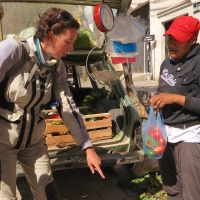 The scale is hanging from the car. For 11 pesos ($1,10) we buy a bag full of vegetables and then we start our ride.
The scale is hanging from the car. For 11 pesos ($1,10) we buy a bag full of vegetables and then we start our ride.
Our destination for today is San Antonio de los Cobres, about 120 km away. From Cachi we follow the same river further north. In this area there are many little chapels along the way for Gauchito Gil and Difunta Correa. The truck driver who just rushed past us, now stands with his hands folded in one of the chapels muttering a prayer. While the road slowly winds up, we can see the valley next to us become deeper. Like yesterday, it is green along the banks of the river, but dry and dusty away from the river. Only the colour of the earth has changed from beige to deep red. The houses and churches we drive past have the same red colour. It’s a beautiful route and we often stop to take pictures. So often that it takes no less than four hours to ride 40 km.
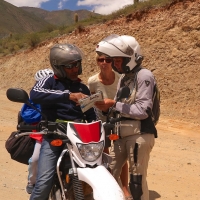 While we are along the side of the road to take a picture, a motorbike stops next to us. An Argentinian and his son. He tells us that the road ahead is closed. Due to the heavy rains of the last days, the road washed out in three places. With the bike we will be able to pass, but it is not possible with a car. That’s a shame because we really wanted to keep following Ruta 40. We turn around and pitch our tent at the same campsite in Cachi a few hours later. We leave the bag with vegetables in the fridge for tomorrow, because today we go out to have dinner. We take a seat on a terrace on the main square. While we enjoy a good piece of Argentinian meat, we enjoy the quiet pace of the village. On the square parade some perky latinas and in front of us a gaucho came to town on his horse for a chat with some friends. A great summer evening in a lovely place!
While we are along the side of the road to take a picture, a motorbike stops next to us. An Argentinian and his son. He tells us that the road ahead is closed. Due to the heavy rains of the last days, the road washed out in three places. With the bike we will be able to pass, but it is not possible with a car. That’s a shame because we really wanted to keep following Ruta 40. We turn around and pitch our tent at the same campsite in Cachi a few hours later. We leave the bag with vegetables in the fridge for tomorrow, because today we go out to have dinner. We take a seat on a terrace on the main square. While we enjoy a good piece of Argentinian meat, we enjoy the quiet pace of the village. On the square parade some perky latinas and in front of us a gaucho came to town on his horse for a chat with some friends. A great summer evening in a lovely place!
Because the road is closed, we have to go via Salta to get to San Antonio de Los Cobres. We take two days for the detour. It fortunately is a beautiful route, which makes up for the detour. The frist day we spend the night at a camp site in the center of Salta. After a restless night in the busy city, we leave early. Once we are out of the city, the scenery is immediately very nice. We ride up into the mountains. The barren hills have lovely colors, like we saw earlier on the border with Chile. Everywhere are cacti that are a few meters high. We continue to climb until we arrive in San Antonio de los Cobres at 3.700 meters altitude. It appears to be a desolate mining town. The center consists mainly of cafes where, at this early hour, quite a few drunken guests have found a spot. Within five minutes we unanimously decide that we do not want to stay here.
It appears to be a desolate mining town. The center consists mainly of cafes where, at this early hour, quite a few drunken guests have found a spot. Within five minutes we unanimously decide that we do not want to stay here.
It’s not that late, so we can still ride to Susques, the next big town. From San Antonio there are two ways to get there: by the old Ruta 40 or the new Ruta 40. We choose the new road, in the hope that it’s in good condition and we arrive in Susques before dark. A few kilometers outside of San Antonio the GPS indicates that we should turn left onto a dirt road. It does not look like the nice new road that we were expecting at all. According to the map it seems to be the right exit, so we turn off to have a look. As we continue the path becomes narrower and the sand deeper. After a few kilometers a car comes from the opposite direction. We beckon him to stop and ask the driver whether this is indeed Ruta 40. The man confirmed that we are on the new Ruta 40. He also tells us that the road is better after a few kilometers and that the new road is much nicer than the old Ruta 40. In consultation with Ton, who must drive the large RV over the dirt road, we decide to continue in the hope that the road indeed improves.
 After a few kilometers the sandy track goes over in a gravel road, which runs through a narrow gorge. The road is just wide enough for one car. In some places the road is washed away and we have to drive through the riverbed. For us that is not a problem, but for Ton in the camper it is a bigger challenge. Luckily he can see the fun of it and steers the car over the large stones and through the deep potholes without any difficulty. A bit further, the road indeed is a bit better. Still, our average speed is not going up much, because there are some treacherous potholes for which Ton has to brake hard. Moreover, it is so beautiful here, that we stop for every photo opportunity. After two hours we leave the gorge and we arrive at a high plain. The GPS indicates that we are at 4.440 m altitude!
After a few kilometers the sandy track goes over in a gravel road, which runs through a narrow gorge. The road is just wide enough for one car. In some places the road is washed away and we have to drive through the riverbed. For us that is not a problem, but for Ton in the camper it is a bigger challenge. Luckily he can see the fun of it and steers the car over the large stones and through the deep potholes without any difficulty. A bit further, the road indeed is a bit better. Still, our average speed is not going up much, because there are some treacherous potholes for which Ton has to brake hard. Moreover, it is so beautiful here, that we stop for every photo opportunity. After two hours we leave the gorge and we arrive at a high plain. The GPS indicates that we are at 4.440 m altitude!
The road stretches in front of us as a straight line and is in good condition so we can make good progress. We drive through some villages and they are nothing like the villages in the valley. While in Cachi the Spanish influences were clearly visible, these clearly are indigenous Qulla villages. The people have characteristic faces, a beautiful long black braid in their hair and wear beautifully coloured costumes. In the meadows are no horses and cows, but llamas. And next to the Catholic church, is a decorated statue of a llama with various offerings in front of it. It is like we have suddenly arrived in another world, a place that has remained beyond the reach of the Spaniards. Very special.
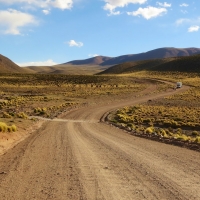 At the end of the day, when the sun begins to sink, the road becomes worse. Our average speed goes right back down. It’s still 30 km to Susques, but at this pace we will not get there before sunset. Driving in the dark is not an option, certainly not on this road. Moreover, we are both very tired from a long tiring day on the bikes. Here on the plateau are no campsites or hotels, so we have to bush camp.
At the end of the day, when the sun begins to sink, the road becomes worse. Our average speed goes right back down. It’s still 30 km to Susques, but at this pace we will not get there before sunset. Driving in the dark is not an option, certainly not on this road. Moreover, we are both very tired from a long tiring day on the bikes. Here on the plateau are no campsites or hotels, so we have to bush camp.
Marijke seems to find it a great adventure, but Ton looks a bit worried. He agrees that it is not safe to keep riding in the dark, and also feels that we have no other option. We find a place to camp next to a watering hole, a few hundred meters from the road. The wind has free play on the plain, so Ton parks the camper in the wind so we can pitch our tent in the lee of the car. Once the sun has set, it’s pretty chilly. We can’t cook in the camper, because the gas cylinders are empty. So while Marijke cuts the vegetables in the camper, I sit outside to prepare dinner on our small fuel stove. Wearing a thick sweater and a hat, because it’s pretty cold.
 If we step outside after dinner, the wind has died. It is very dark and very quiet. We sometimes wonder whether there are still places in the Netherlands where it gets this quiet at night. Ton takes out his camera and makes a beautiful picture of the camper in the dark night. The next morning we begin to pack our tent at the first light. Ton steps out of the camper smiling. He slept like a baby. His worries of the night before are gone, and are now replaced by a sense of freedom: “What a privilege to just park your camper somewhere to camp under the stars.” We cannot suppress a small smile and are happy that we were able to share this piece of our trip with them.
If we step outside after dinner, the wind has died. It is very dark and very quiet. We sometimes wonder whether there are still places in the Netherlands where it gets this quiet at night. Ton takes out his camera and makes a beautiful picture of the camper in the dark night. The next morning we begin to pack our tent at the first light. Ton steps out of the camper smiling. He slept like a baby. His worries of the night before are gone, and are now replaced by a sense of freedom: “What a privilege to just park your camper somewhere to camp under the stars.” We cannot suppress a small smile and are happy that we were able to share this piece of our trip with them.
During breakfast we are visited by a shepherd. His llamas graze on the hills behind us. He greets us kindly, tells he is from the next village and asks if we slept well. Then he trudges back to his animals, closely followed by his dog. We pack everything back on the bikes and ride the last 30 km to Susques. In the daylight we can see that we made a good decision the night before to bush camp. The road was winding and sandy, difficult terrain in the dark. Moreover Susques turned out to be just as gloomy as San Antonio. Our 1000-star campsite was definitely a much better place to stay.
 From Susques we drive towards the border with Chile. The first part there are still some shrubs along the road where llamas graze, but once we continue to climb all vegetation disappears. What remains is lunar landscape, with beautiful colors and the snow-capped volcanoes of Chile in the distance. Read all about the ’land of volcanoes’ in the next blog post.
From Susques we drive towards the border with Chile. The first part there are still some shrubs along the road where llamas graze, but once we continue to climb all vegetation disappears. What remains is lunar landscape, with beautiful colors and the snow-capped volcanoes of Chile in the distance. Read all about the ’land of volcanoes’ in the next blog post.
Distance travelled to Bush Camp at Susques = 48 659 km (30 235 miles)
CLICK HERE FOR PHOTOS FOR THIS POST.
PS: Our routes are now also on the website. This allows you to keep better track of where we’ve been and where we are now. Click here to view the routes.
Previous story “Colourful mountains” – Next story “Land of vulcanoes“





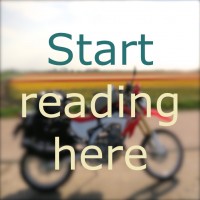


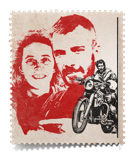
Prachtig prachtig, wat een schitterend gebied!
Lijkt me ook wel wat zo’n 1000 sterrencamping.
Liefs, Mieke
Wat een heerlijk verhaal weer en prachtige foto’s!!
Dikke kus xxx
Wat n zoet hondekind! Grappig; wij hadden in Chili ook ineens drie dagen n hond :-). Prachtige foto’s, leuk dat jullie samen met de ouders van Peter dit stuk van de reis konden delen.
Veel knuf, tot later!
Het is fijn weer een nieuw avontuur van jullie te lezen. Ik heb respect voor je dat je het steeds voor elkaar krijgt om weer een nieuw verhaal met ons te delen, nu al bijna twee jaar!
Goede reis verder!
Groeten, Jan.